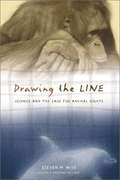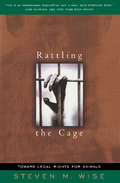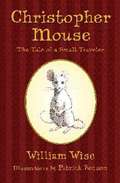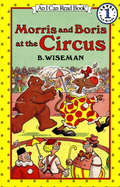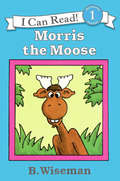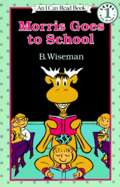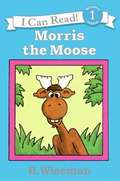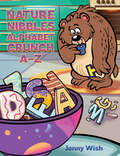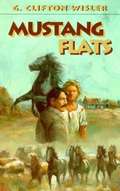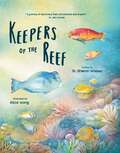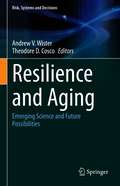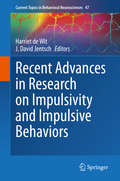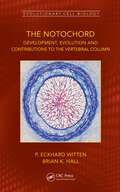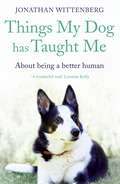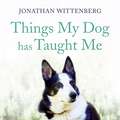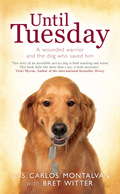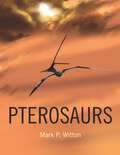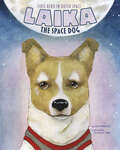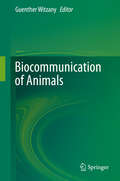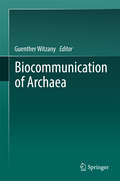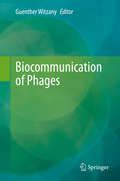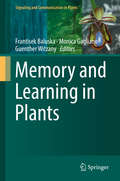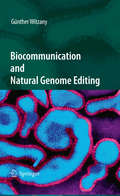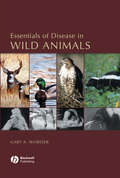- Table View
- List View
Drawing the Line: Science and the Case for Animal Rights
by Steven M. WiseAre we ready for parrots and dolphins to be treated as persons before the law? In this unprecedented exploration of animal cognition along the evolutionary spectrum--from infants and children to other intelligent primates, from dolphins, parrots, elephants, and dogs to colonies of honeybees--Steve Wise finds answers to the big question in animal rights today: Where do we draw the line? Readers will be enthralled as they follow Wise's firsthand account of the world's most famous animal experts at work: Cynthia Moss and the touchingly affectionate families of Amboseli; Irene Pepperberg and her amazing and witty African Grey parrot, Alex; and Penny Paterson with the formidable gorilla Koko. In many cases, Wise was able to sustain an extended conversation with these extraordinary creatures. No one with even a shred of curiosity about animal intelligence or justice will want to miss this book.
Rattling the Cage: Toward Legal Rights for Animals
by Steven M. Wise Jane GoodallThis is an impassioned, fascinating, and in many ways startling book. --Cass Sunstein, "New York Times Book Review. "
Ten Sly Piranhas: A Counting Story In Reverse (a Tale Of Wickedness - And Worse!)
by William WiseA school of ten sly piranhas gradually dwindles as they waylay and eat each other.
Christopher Mouse: The Tale Of A Small Traveler
by William Wise Patrick BensonThough his life begins "in a commonplace way," Christopher Mouse is not the least bit common. Born in an ordinary wire cage, he endures various young owners who range from bad to worse before narrowly escaping death by taxidermy. His adventures continue in the Metropolitan Museum of Art as he encounters a large cat in the Egyptian room. Throughout his journeys, Christopher proves an adventurer of the most intrepid sort-and a budding poet as well. With the delightful feel of a lost (and found) classic, this is the story of an extraordinary mouse who, through strong will and good luck, finds his own small way in a very large world.
Morris and Boris at the Circus (I Can Read Level 1)
by B. WisemanThis classic story about a mixed-up moose and his exasperated friend Boris is perfect for fans of Amelia Bedelia, Danny and the Dinosaur, and anyone who loves silly stories and fun word play.Morris the Moose has never been to the circus, so his friend Boris takes him there. When the ringmaster invites Morris to be part of the show, the fun begins for everyone—except poor Boris!This classic silly Level One I Can Read is perfect for shared reading with a child.
Morris the Moose (I Can Read Level 1)
by B. WisemanThis classic story about a mixed-up moose is perfect for fans of Amelia Bedelia, Danny and the Dinosaur, and anyone who loves silly stories and fun word play.The cow, the deer, and the horse have four legs and a tail, just like Morris. But none of these animals is a moose! These different animals have one thing in common—their friendship. Morris the Moose is a Level One I Can Read, great for shared reading with a child, and especially wonderful for reluctant readers.
Morris Goes To School (I Can Read #Level 1)
by Bernard WisemanMorris the Moose can't read or count, so he decides to go to school. After a day of ABCs and 123s, Morris is thrilled with all that he has learned. This classic silly Level One I Can Read is perfect for shared reading with a child. For fans of Danny and the Dinosaur, Sammy the Seal, or anyone who loves to read silly stories about animals.
Morris The Moose (I Can Read Level 1)
by Bernard WisemanThis classic story about a mixed-up moose is perfect for fans of Amelia Bedelia, Danny and the Dinosaur, and anyone who loves silly stories and fun word play. The cow, the deer, and the horse have four legs and a tail, just like Morris. But none of these animals is a moose! These different animals have one thing in common—their friendship. Morris the Moose is a Level One I Can Read, great for shared reading with a child, and especially wonderful for reluctant readers.
Nature Nibbles: Alphabet Crunch A-Z
by Jenny WishNature Nibbles: Alphabet Crunch A-Z celebrates the twist and turn of letters in rhyme. Whimsical and wacky, nature bites their way to unexpected choices. Children will giggle their way in fun while learning the alphabet. This charming little book celebrates unleashed imagination for the early learner and their parents. Nibble away!
Mustang Flats
by G. Clifton WislerWhen his father returns from the war in 1865, fourteen-year-old Alby finds his beloved Pa a changed man and can only hope that they will be friends again.
Keepers of the Reef
by Sharon WismerTakes children to the underwater world of Australia's Great Barrier Reef for a prime example of how a complex ecosystem depends on its keystone species. Sharon Wismer—reef ecologist and mom—is the best tour guide a kid could have for a visit to the underwater world of Australia’s Great Barrier Reef. Alice Wong’s richly detailed, accurate watercolors take a boy and girl snorkeling to see the fishes that maintain the ecological balance between the corals and their main competitor, algae. Without the fish species that brush, crop, scrape, excavate, and browse the algae, coral reefs would die. A coral reef is a brilliant and colorful example of how a complex ecosystem functions and why its keystone species are critical to its health. The Great Barrier Reef is one of Earth’s most celebrated natural treasures. Here children discover why the reef is threatened and what we can all do to help protect it. Endorsements are coming from Charlie Veron (“the godfather of coral,” featured in the 2017 film Chasing Coral) and David Bellwood, a world-renowned reef fish ecologist whose lab is the source of much of the information in this book. Keepers of Reef is the rare children’s book combining cutting-edge science with narrative and pictorial magic. Thorough backmatter sources and resources are included.
Resilience and Aging: Emerging Science and Future Possibilities (Risk, Systems and Decisions)
by Andrew V. Wister Theodore D. CoscoOlder aged adults face many adversities over the later life course. This edited volume will address the ways in which seniors bounce back from different types and combinations of adversity – termed “resilience”. While research has been accumulating that identifies inherent abilities and external resources needed to adapt and navigate stress-inducing experiences among aging and older adults, gaps remain in understanding the unique elements and processes of resilience. A series of chapters included in this book will address several overarching questions: why do some older individuals/families/communities adapt to adversity better than others; what are modifiable behavioral protective/risk factors related to resilience; and how can we foster resilience at the individual/community level and which approaches show the most promise?The spectrum of aging-related challenges and responses addressed in this book include: mental health; physical/functional health problems; multimorbidity; socio-economic deprivation; social isolation and loneliness; cultural dimensions of loneliness; housing/homelessness problems; and environmental disasters. This book presents cutting-edge science at the conceptual, methodological, empirical and practice levels applied to emerging resilience sub-fields in gerontology. It will also present potential areas of future research, policy and practice linked to these areas.During a period of the most rapid population aging in the US, Canada and many other nations, coupled with heightened global socio-political change, extending our knowledge of resilience will help society to make important adjustments to maximize health and wellness of older individuals. Supporting and enhancing resilience through technological, social and/or community-level advances in geroscience will help those facing adversity to thrive by harnessing, stretching, and leveraging a wide array of potential resources. The promotion of healthier older populations has far-reaching consequences for health care and social/community support systems, both in terms of public health including pandemic response, and the development and implementation of innovations in treatment and practice guidelines.
Recent Advances in Research on Impulsivity and Impulsive Behaviors (Current Topics in Behavioral Neurosciences #47)
by Harriet De Wit J. David JentschThis volume provides an empirical and conceptual overview of advances in our understanding of impulsivity and impulsive behaviors. Prominent scientists review the range of behavioral phenomena referred to as ‘impulsive’, as well as the defining features and psychological, neurocognitive and behavioral processes that underlie of the manifestation of impulsive behaviors, focussing on progress made and the questions remaining to be answered.
The Notochord: Development, Evolution and contributions to the vertebral column (Evolutionary Cell Biology)
by P. Eckhard Witten Brian K. HallAlthough it is the defining organ of the Chordata, the notochord and its cells are one of the least understood vertebrate organs. This may be because large parts of the notochord are often replaced with cartilaginous or bony vertebral bodies. The presence of cartilage in the notochord raises questions about the evolutionary relationships between notochord cells and cartilage cells. This book integrates classical analytical studies with recent palaeontological, experimental, and molecular studies in both developmental and evolutionary contexts. For example, although the early signaling function of the notochord is conserved across the vertebrates, many will be surprised to find that the role of the notochord in vertebral body development in tetrapods is not the blueprint for all vertebrates. Recent studies on zebrafish and medaka embryos have uncovered the molecular mechanisms of a somite-independent notochord-driven segmentation process that establishes vertebral centra and intervertebral spaces. As this process is not restricted to teleosts, the authors have written a general discussion about the role of the notochord in vertebral formation. Modularity and segmentation of the vertebral column are related topics. Further overarching themes are the structure, function and fate of the notochord in adult vertebrates and notochord–cartilage relationships. Key Features The first book devoted to notochord development, function and evolution Includes and integrates information on the notochord from studies going back 169 years Integrates developmental, molecular, functional, experimental and palaeontological studies Documents the fate of the notochord across the vertebrates Extensively illustrated with classical and new images Related Titles Bard, J. Evolution: The Origins and Mechanisms of Diversity (ISNB 978-0-3673-5701-6) Leys, S. and Hejnol. A. Origin and Evolution of Metazoan Cell Types (ISBN 978-1-1380-3269-9)
Things My Dog Has Taught Me: About being a better human
by Jonathan Wittenberg'A wonderful read' -- Lorraine KellyIn this book for dog lovers everywhere, Jonathan Wittenberg says his dogs have taught him, more than anything else, how to appreciate the wonderful world in which we live -- and how to develop better relationships with his friends and families. In this wonderful, warm account of one man and his dog, Jonathan brings all the big themes of friendship, faithfulness, kindness, cruelty, grief, prayer and spiritual companionship to the fore, and shows us how we can learn so much from a dog's approach to life. If you're one of the 8.5 million dog owners in the UK the answer to a better way of living may already be under your roof.
Things My Dog Has Taught Me: About being a better human
by Jonathan WittenbergA dog's guide to life - how to be a kinder, compassionate, more mindful and wiser human.Anyone who has ever fallen hopelessly in love with a dog will know dogs have the capacity to love us back unconditionally, welcome us home with unbridled excitement, forgive us endlessly for our impatience, comfort us when we're feeling low - and then play games with wholehearted contentment - bringing endless joy to our lives.Dogs' sheer zest for embracing life in all its fullness is something we humans can only marvel at. But can our dogs teach us to approach life in this full, technicolour way too? How to love and care for one another with unconditional acceptance; how to be fully present in someone's company; how to be more mindful of the beauty of the natural world around us; how to comfort each other when we're grieving or afraid; and, how to let excitement and joy bubble over in our hearts.Dogs do all these things instinctively and more naturally than their human friends - yet they love us just the same. And in this charming and entertaining story of his beloved canine companion, Jonathan Wittenberg shares with dog lovers everwhere his inability to resist the big, brown-eyed look which says, 'I'll melt your heart if you even think of going out without me', to the security he feels on a twenty-mile trek across the bleak Scottish Highlands with not a soul for a friend but his collie - and everything else he's learned along the way.(P)2017 John Murray Press
Until Tuesday: A Wounded Warrior And The Golden Retriever Who Saved Him
by Bret Witter Luis Carlos MontalvánUNTIL TUESDAY is the story of how Tuesday, a service dog, helps to heal a shattered soldier. Luis Carlos Montalván is a 17-year veteran and retired captain of the US Army. Even after suffering stab wounds, a traumatic brain injury and three broken vertebrae, Captain Luis chose to remain at his post on the Iraq-Syria border. In his mind, he had come this far, now wasn't the time to abandon his comrades. However, when Luis returned home, the pressures and injuries proved too much to bear. Physical disabilities, agoraphobia and crippling PTSD drove him to the brink of suicide. And that's when he met Tuesday. UNTIL TUESDAY entwines Luis' story of courage and bravery with that of his trusted dog, Tuesday, and shows how a brave soldier who fought tirelessly for his country, found a way back from the devastation of being injured in action, with the help of his canine friend.
Pterosaurs: Natural History, Evolution, Anatomy
by Mark P. WittonThe most authoritative illustrated book on flying reptiles availableFor 150 million years, the skies didn't belong to birds—they belonged to the pterosaurs. These flying reptiles, which include the pterodactyls, shared the world with the nonavian dinosaurs until their extinction 65 million years ago. Some pterosaurs, such as the giant azhdarchids, were the largest flying animals of all time, with wingspans exceeding thirty feet and standing heights comparable to modern giraffes. This richly illustrated book takes an unprecedented look at these astonishing creatures, presenting the latest findings on their anatomy, ecology, and extinction.Pterosaurs features some 200 stunning illustrations, including original paintings by Mark Witton and photos of rarely seen fossils. After decades of mystery, paleontologists have finally begun to understand how pterosaurs are related to other reptiles, how they functioned as living animals, and, despite dwarfing all other flying animals, how they managed to become airborne. Here you can explore the fossil evidence of pterosaur behavior and ecology, learn about the skeletal and soft-tissue anatomy of pterosaurs, and consider the newest theories about their cryptic origins. This one-of-a-kind book covers the discovery history, paleobiogeography, anatomy, and behaviors of more than 130 species of pterosaur, and also discusses their demise at the end of the Mesozoic.The most comprehensive book on pterosaurs ever publishedFeatures some 200 illustrations, including original paintings by the authorCovers every known species and major group of pterosaursDescribes pterosaur anatomy, ecology, behaviors, diversity, and moreEncourages further study with 500 references to primary pterosaur literature
Biocommunication of Animals
by Guenther WitzanyEvery coordination within or between animals depends on communication processes. Although the signaling molecules, vocal and tactile signs, gestures and its combinations differ throughout all species according their evolutionary origins and variety of adaptation processes, certain levels of biocommunication can be found in all animal species: (a) Abiotic environmental indices such as temperature, light, water, etc. that affect the local ecosphere of an organism and are sensed, interpreted. (b) Trans-specific communication with non-related organisms. (c) Species-specific communication between same or related species. (d) Intraorganismic communication, i. e. , sign-mediated coordination within the body of the organism. This book gives an overview of the manifold levels of animal communication exemplified by a variety of species and thereby broadens the understanding of these organisms.
Biocommunication of Archaea
by Guenther WitzanyArchaea represent a third domain of life with unique properties not found in the other domains. Archaea actively compete for environmental resources. They perceive themselves and can distinguish between 'self' and 'non-self'. They process and evaluate available information and then modify their behaviour accordingly. They assess their surroundings, estimate how much energy they need for particular goals, and then realize the optimum variant. These highly diverse competences show us that this is possible owing to sign(aling)- mediated communication processes within archaeal cells (intra-organismic), between the same, related and different archaeal species (interorganismic), and between archaea and nonarchaeal organisms (transorganismic). This is crucial in coordinating growth and development, shape and dynamics. Such communication must function both on the local level and between widely separated colony parts. This allows archaea to coordinate appropriate response behaviors in a differentiated manner to their current developmental status and physiological influences. This book will orientate further investigations on how archaeal ecosphere inhabitants communicate with each other to coordinate their behavioral patterns and whats the role of viruses in this highly dynamic interactional networks.
Biocommunication of Phages
by Guenther WitzanyThis is the first book to systemize all levels of communicative behavior of phages. Phages represent the most diverse inhabitants on this planet. Until today they are completely underestimated in their number, skills and competences and still remain the dark matter of biology. Phages have serious effects on global energy and nutrient cycles. Phages actively compete for host. They can distinguish between ‘self’ and ‘non-self’ (complement same, preclude others). They process and evaluate available information and then modify their behaviour accordingly. These diverse competences show us that this capacity to evaluate information is possible owing to communication processes within phages (intra-organismic), between the same, related and different phage species (interorganismic), and between phages and non-phage organisms (transorganismic). This is crucial in coordinating infection strategies (lytic vs. lysogenic) and recombination in phage genomes.In 22 chapters, expert contributors review current research into the varying forms of phage biocommunication and Phagetherapy. Biocommunication of Phages aims to assess the current state of research, to orient further investigations on how phages communicate with each other to coordinate their behavioral patterns, and to inspire further investigation of the role of non-phage viruses (non-lytic, non-prokaryotic) in these highly dynamic interactional networks.
Memory and Learning in Plants (Signaling and Communication in Plants)
by Guenther Witzany Monica Gagliano Frantisek BaluskaThis book assembles recent research on memory and learning in plants. Organisms that share a capability to store information about experiences in the past have an actively generated background resource on which they can compare and evaluate coming experiences in order to react faster or even better. This is an essential tool for all adaptation purposes. Such memory/learning skills can be found from bacteria up to fungi, animals and plants, although until recently it had been mentioned only as capabilities of higher animals. With the rise of epigenetics the context dependent marking of experiences on the genetic level is an essential perspective to understand memory and learning in organisms. Plants are highly sensitive organisms that actively compete for environmental resources. They assess their surroundings, estimate how much energy they need for particular goals, and then realize the optimum variant. They take measures to control certain environmental resources. They perceive themselves and can distinguish between ‘self’ and ‘non-self’. They process and evaluate information and then modify their behavior accordingly. The book will guide scientists in further investigations on these skills of plant behavior and on how plants mediate signaling processes between themselves and the environment in memory and learning processes.
Biocommunication and Natural Genome Editing
by Günther WitzanyThis is the first uniform description of all key levels of communication in the organismic kingdoms of plants, fungi, animals and bacteria based on the most recent empirical data. Biocommunication occurs on three levels (A) intraorganismic, i.e. intra- and intercellular, (B) interorganismic, between the same or related species and (C) transorganismic, between organisms which are not related. The biocommunicative approach demonstrates both that cells, tissues, organs and organisms coordinate and organize by communication processes and genetic nucleotide sequence order in cellular and non-cellular genomes is structured language-like, i.e. follow combinatorial (syntactic), context-sensitive (pragmatic) and content-specific (semantic) rules. Without sign-mediated interactions no vital functions within and between organisms can be coordinated. Exactly this feature is absent in non-living matter. Additionally the biocommunicative approach investigates natural genome editing competences of viruses. Natural genome editing from a biocommunicative perspective is competent agent-driven generation and integration of meaningful nucleotide sequences into pre-existing genomic content arrangements and the ability to (re)combine and (re)regulate them according to context-dependent (i.e. adaptational) purposes of the host organism. The biocommunicative approach is an original scientific field of investigations. Readers must be competent in basic knowledge of biology and genetics.
Essentials of Disease in Wild Animals
by Gary A. WobeserThe interrelationship between wild animal, domestic animals and human health is appreciated now more than ever before. This is because of the recognition of the involvement of wild animals in diseases of humans and domestic animals, the impact of disease on wildlife management and conservation biology, recognition of new forms of environmental contamination, and academic interest in disease as an ecological factor. This is the first introductory level book about disease in wild animals that deals with basic subjects such as the nature of disease, what causes disease, how disease is described and measured, how diseases spread and persist and the effects of disease on individual animals and populations. In contrast to authors of many other veterinary books, Gary A. Wobeser takes a more general approach to health in wild animals, recognizing that disease is one ecological factor among many and that disease can never be considered satisfactorily in isolation. Rather than focus on individual causative agents and their effect on the individual animal, the emphasis is on why disease occurred, and on the complex interactions that occur among disease agents, the environment and host populations. Written by a leading researcher in wildlife diseases, this book will fill a knowledge gap for those called to work with disease in wild animals who lack experience or training in the general features of disease as they relate to wild animals. Veterinarians, ecologists, wildlife biologists, population biologists and public health workers will find this book invaluable.
